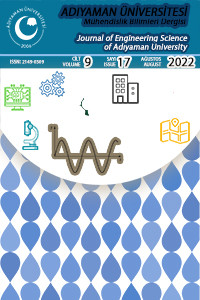Öz
Yenilenebilir enerji kaynaklarından biri olan güneş enerjisi, termal enerji elde etmek için yaygın olarak kullanılmaktadır. Güneş enerjisinden elde edilen ısı farklı sistemler kullanılarak depolanabilir. Bu sistemlerden biri de güneş havuzlarıdır. Güneş havuzları, tuz yoğunluğu tabana doğru artan katmanlardan oluşur. Bu çalışmada, bir model güneş havuzunun ısı depolama performansını artırmak için faz değiştiren malzemelerin kullanımı araştırılmıştır. Faz değiştirici malzeme olan Cetyl-palmitic asitin ötektik karışımı hazırlanmış ve kimyasal özellikleri FT-IR spektroskopisi ile elde edilmiştir. Termofiziksel özellikler ve yüzey morfolojileri, diferansiyel taramalı kalorimetri ve SEM kullanılarak belirlenmiştir. Elde edilen faz değişim malzemesi ısı depolama bölgesinin iç yüzeyine uygulanmıştır. Güneş havuzunun sıcaklık dağılımı, faz değiştiren malzemeli ve faz değiştiren malzemesiz için sayısal olarak hesaplanmıştır. Sonuç olarak güneş havuzlarında uygun termofiziksel özelliklere sahip faz değiştiren malzemelerin kullanılmasının uzun süreli ısı depolama performansına katkı sağlayacağı görülmüştür.
Anahtar Kelimeler
Güneş enerjisi güneş havuzları ısı depolama faz değiştirici malzemeler
Kaynakça
- Dincer I, Rosen MA. Thermal Energy Storage: Systems and Applications. John Wiley and Sons, New York, 2011.
- Sogukpınar H, Bozkurt I. Investigation of saturation temperature in solar pond for different sizes, Thermal Science; 2020: 24 No. 5A: 2905-2914.
- Sogukpinar H, Bozkurt I, Karakilcik M, Cag S. Numerical Evaluation of the Performance Increase for a Solar Pond With Glazed and Unglazed, 2016 IEEE International Conference on Power and Renewable Energy; DOI: 10.1109/ICPRE.2016.7871146: 598-601.
- Bozkurt I, Karakilcik M. The daily performance of a solar pond integrated with solar collectors. Solar Energy 2012; 86: 1611–1620.
- Tian D, Qu ZG, Zhang JF, Ren QL. Enhancement of solar pond stability performance using an external magnetic field, Energy Conversion and Management, 2021; 243: 114427.
- Colarossi D, Principi P. Experimental investigation and optical visualization of a salt gradient solar pond integrated with PCM, Solar Energy Materials & Solar Cells, 2022; 234: 111425.
- Assari MR, Tabrizi HB, Beik AJG. Experimental studies on the effect of using phase change material in salinity-gradient solar pond, Solar Energy, 2015; 122: 204–214.
- Ines M, Paolo P, Roberto F, Mohamed S. Experimental studies on the effect of using phase change material in a salinity-gradient solar pond under a solar simulator, Solar Energy, 2019; 186: 335–346.
- Wang H, Zhang CY, Zhang LG. Effect of steel-wires and paraffin composite phase change materials on the heat exchange and exergetic performance of salt gradient solar Pond, Energy Reports 2022; 8: 5678–5687.
- Poyyamozhi N, Karthikeyan A. Performance comparison of AgTiO2 and CNT based latent heat materials on a solar pond, Materials Today: Proceedings 2021; 47: 4548–4551.
- Heat transfer module, COMSOL. https://www.comsol.com/[accessed 22 February 2022]
- Bozkurt I, Karakilcik M and Dincer I. Energy efficiency assessment of integrated and nonintegrated solar ponds, International Journal of Low-Carbon Technologies, 2014; 9: 45–51
Öz
Solar energy is one of the renewable energy sources and widely used to obtain thermal energy. The heat obtained from solar energy can be stored by using different systems. One of these systems is solar ponds. Solar ponds consist of layers whose salt density increases towards the bottom. In this study, the use of phase change materials to increase the heat storage performance of a model solar pond was investigated. The phase change material, Cetyl-palmitic acid eutectic mixture was prepared and its chemical properties were obtained by FT-IR spectroscopy. The thermophysical properties and surface morphologies were determined by using Differential Scanning Calorimetry and SEM. The obtained phase change material was applied to the inner surface of the heat storage zone. The temperature distribution of the solar pond was calculated numerically for with and without phase change material. As a result, it has been seen that the use of phase change materials with suitable thermophysical properties in solar ponds will contribute to long-term heat storage performance.
Anahtar Kelimeler
Kaynakça
- Dincer I, Rosen MA. Thermal Energy Storage: Systems and Applications. John Wiley and Sons, New York, 2011.
- Sogukpınar H, Bozkurt I. Investigation of saturation temperature in solar pond for different sizes, Thermal Science; 2020: 24 No. 5A: 2905-2914.
- Sogukpinar H, Bozkurt I, Karakilcik M, Cag S. Numerical Evaluation of the Performance Increase for a Solar Pond With Glazed and Unglazed, 2016 IEEE International Conference on Power and Renewable Energy; DOI: 10.1109/ICPRE.2016.7871146: 598-601.
- Bozkurt I, Karakilcik M. The daily performance of a solar pond integrated with solar collectors. Solar Energy 2012; 86: 1611–1620.
- Tian D, Qu ZG, Zhang JF, Ren QL. Enhancement of solar pond stability performance using an external magnetic field, Energy Conversion and Management, 2021; 243: 114427.
- Colarossi D, Principi P. Experimental investigation and optical visualization of a salt gradient solar pond integrated with PCM, Solar Energy Materials & Solar Cells, 2022; 234: 111425.
- Assari MR, Tabrizi HB, Beik AJG. Experimental studies on the effect of using phase change material in salinity-gradient solar pond, Solar Energy, 2015; 122: 204–214.
- Ines M, Paolo P, Roberto F, Mohamed S. Experimental studies on the effect of using phase change material in a salinity-gradient solar pond under a solar simulator, Solar Energy, 2019; 186: 335–346.
- Wang H, Zhang CY, Zhang LG. Effect of steel-wires and paraffin composite phase change materials on the heat exchange and exergetic performance of salt gradient solar Pond, Energy Reports 2022; 8: 5678–5687.
- Poyyamozhi N, Karthikeyan A. Performance comparison of AgTiO2 and CNT based latent heat materials on a solar pond, Materials Today: Proceedings 2021; 47: 4548–4551.
- Heat transfer module, COMSOL. https://www.comsol.com/[accessed 22 February 2022]
- Bozkurt I, Karakilcik M and Dincer I. Energy efficiency assessment of integrated and nonintegrated solar ponds, International Journal of Low-Carbon Technologies, 2014; 9: 45–51
Ayrıntılar
| Birincil Dil | İngilizce |
|---|---|
| Konular | Mühendislik |
| Bölüm | Makaleler |
| Yazarlar | |
| Yayımlanma Tarihi | 31 Ağustos 2022 |
| Gönderilme Tarihi | 25 Şubat 2022 |
| Yayımlandığı Sayı | Yıl 2022 Cilt: 9 Sayı: 17 |


